
Elsevier, The Lancet Public Health, Volume 6, July 2021
Background: WHO has launched an initiative aiming to eliminate cervical cancer as a public health problem. Elimination is a long-term target that needs long-lasting commitment. To support local authorities in implementing human papillomavirus (HPV) vaccination, we provide regional and country-specific estimates of cervical cancer burden and the projected impact of HPV vaccination among today's young girls who could develop cervical cancer if not vaccinated. Methods: The expected number of cervical cancer cases in the absence of vaccination among girls born between 2005 and 2014 was quantified by combining age-specific incidence rates from GLOBOCAN 2018 and cohort-specific mortality rates by age from UN demographic projections. Preventable cancers were estimated on the basis of HPV prevalence reduction attributable to vaccination and the relative contribution of each HPV type to cervical cancer incidence. We assessed the number of cervical cancer cases preventable through vaccines targeting HPV types 16 and 18, with and without cross-protection, and through vaccines targeting HPV types 16, 18, 31, 33, 45, 52, and 58. Findings: Globally, without vaccination, the burden of cervical cancer in these birth cohorts is expected to reach 11·6 million (95% uncertainty interval 11·4–12·0) cases by 2094. Approximately 75% of the burden will be concentrated in 25 countries mostly located in Africa and Asia, where the future number of cases is expected to increase manyfold, reaching 5·6 million (5·4–6·0) cases in Africa and 4·5 million (4·4–4·6) cases in Asia. Worldwide immunisation with an HPV vaccine targeted to HPV types 16 and 18, with cross-protection against HPV types 31, 33, and 45, could prevent about 8·7 million (8·5–9·0) cases. Interpretation: Detailed estimates of the increasing burden of cervical cancer and projected impact of HPV vaccination is of immediate relevance to public health decision makers. Shifting the focus of projections towards recently born girls who could develop cervical cancer if not vaccinated is fundamental to overcome stakeholders' hesitancy towards HPV vaccination. Funding: Bill & Melinda Gates Foundation, Canadian Institutes of Health Research.
